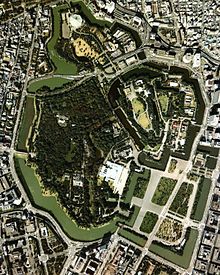Tokyo Imperial Palace
The Tokyo Imperial Palace ( Japanese 皇居 , Kōkyo , lit. "Imperial Residence") is the residence of Tennō , the Japanese emperor. The imperial residence is located on the former site of Edo Castle in what is now the Chiyoda district of the district of the same name in central Tokyo .
Emergence
After the Meiji restoration and the shogun's disempowerment, the imperial court was relocated from Kyoto to Edo, which was renamed Tōkyō or Tōkei ("eastern capital") at that time. The city's castle, until then the seat of the Tokugawa shoguns, was visited by the emperor on November 26, 1868 and renamed Tōkei-jō ( 東京 城 , dt. "Castle of the Eastern Capital"). On May 9, 1869, he made the residence used by the last shogun in the western district (Nishi-no-maru) his permanent seat and renamed it Kōjō ( 皇城 , dt. "Imperial Castle"). This residence burned down on May 5, 1873. Until the completion of the new residence in the same place in the Japanese-Western mixed style in 1888, called Kyūjō ( 宮城 , English "palace castle"), the imperial family used the Akasaka Imperial Residence for 15 years . The palace was given its current name in 1948.
The Imperial Court Office is also located on the grounds of the palace .
The buildings were destroyed by bombs during World War II and rebuilt in a modern style by 1968.
At the time of the Japanese bubble economy from the late 1980s to 1990, the palace grounds of 110,000 m 2 were considered to be just as expensive as the entire US state of California .
Access
The palace is guarded by the " imperial palace police ". Most of the palace is usually only open to the public for a visitor tour by prior arrangement. The buildings themselves cannot be entered. On the emperor's birthday (February 23) and on New Year's (January 2), the inner palace grounds are accessible without registration. The Eastern Gardens are open all year round, except on Mondays and Fridays and some special days.
The Imperial Palace can be reached via two bridges: from the public apron, on special occasions (see above), one crosses the two -arched stone bridge Seimon-ishibashi from right to left , passes the Nishi-no-maru Ōte-mon gate , then crosses from left to left on the right the short, high iron bridge Nijūbashi . This bridge was designed by the German Wilhelm Heise (1846–1895), who was awarded a medal for it by the Japanese government. Nijūbashi means "double bridge" and was originally the name of the wooden predecessor construction, which was designed as a double bridge. In parlance today, both bridges are referred to together as Nijūbashi, because from certain perspectives the front stone bridge and the rear iron bridge appear like a double bridge.
You pass another gate and find yourself in front of the palace.
Sand Kyūchū
In the palace are the Kyūchū sanden ( 宮中 三 殿 ), the "three sanctuaries in the palace", as personal Shintō shrines of the emperor and his family. These are:
- Kashiko-dokoro ( 賢 所 , "place of reverence"), also called Naiji-dokoro ( 内侍 所 ) and Unmei-den ( 温 明 殿 ), in which a replica from the time of the mythological emperor Sujin (1st / 2nd cent. Century BC) of the Yata no Kagami mirror , one of the three throne insignia of Japan ,
- Kōrei-den ( 皇 霊 殿 , "Hall of the Imperial Ancestral Souls"), in which the ancestors of the emperor and the imperial family are venerated,
- Shinden ( 神殿 , "hall of the gods"), where the Tenjinchigi , the kami of heaven and earth, are worshiped.
See also
Remarks
- ↑ Heise came to Japan in 1871 as O-yatoi gaikokujin . He died in Tokyo and is buried in Aoyama Cemetery.
Individual evidence
- ↑ 皇居 . In: 通信 用語 の 基礎 知識 . Retrieved March 10, 2012 (Japanese).
- ^ Area according to the Tokyo travel guide from sueddeutsche.de , accessed on February 11, 2016.
- ^ Property value 1990 according to ZEIT ONLINE , accessed on February 11, 2016.
- ↑ Takeuchi, Hiroshi: Rainichi Seiyō jimmei jiten. Kinokuniya 1983. ISBN 4-8169-0215-5 .
- ↑ Sakamoto Koremaru: " Sanden Kyūchū" . In: Encyclopedia of Shinto. Kokugaku-in , March 28, 2007 (English)
- ↑ Fukui Yoshihiko: "Sanshu no shinki" . In: Encyclopedia of Shinto. Kokugaku-in , March 22, 2007 (English)
Web links
- Description of the Imperial Palace at the Imperial Court Office (English)
- Photos from the Emperor's birthday
Coordinates: 35 ° 40 ′ 57.4 " N , 139 ° 45 ′ 9.9" E



